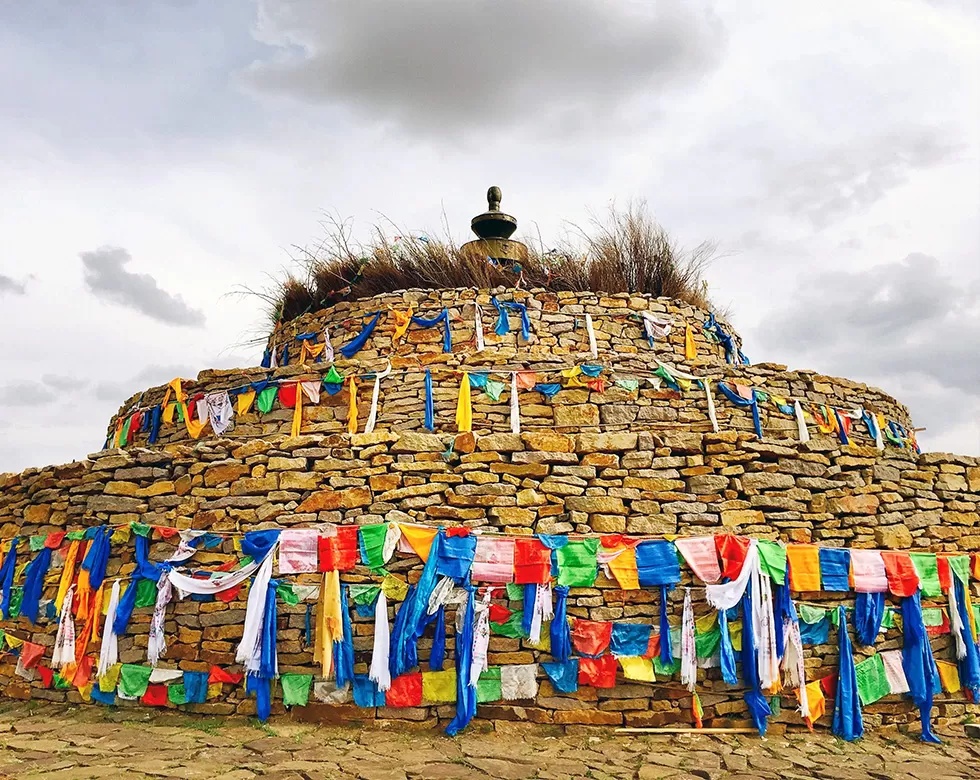Inner Mongolia Local Culture
Offering Sacrifices to Aobaos
 Aobao Groups
Aobao GroupsAobao is translated as a pile of stones in Mongolian. Aobao is generally built in high hills with piles of stones. It has the shape of a round ball, or it is round on its top and rectangular in its base, resembling a beacon tower. There is a long pole sticking to its top; horns of domesticated animals, flags of scriptures and colorful ribbons are tied to the pole. The items inside the Aobaos are various: some have five cereals; some have bows and arrows; some have Buddhist statures. Most of the Aobaos stand alone on the hills, but there are groups of Aobaos that amount to between 7 and 13 of them. The Aobao standing in the middle is bigger than its surrounding ones. Once Aobaos are built up, every year, the nearby residents will go there and offer sacrifices to pray for a better life. Offering sacrifices to Aobaos is the most important and prevailing sacrificial activity for the Mongolian people. On May 20, 2006, this custom was placed on the first List of Chinese Intangible Cultural Heritages with the permission of the State Council.
Historical Origin
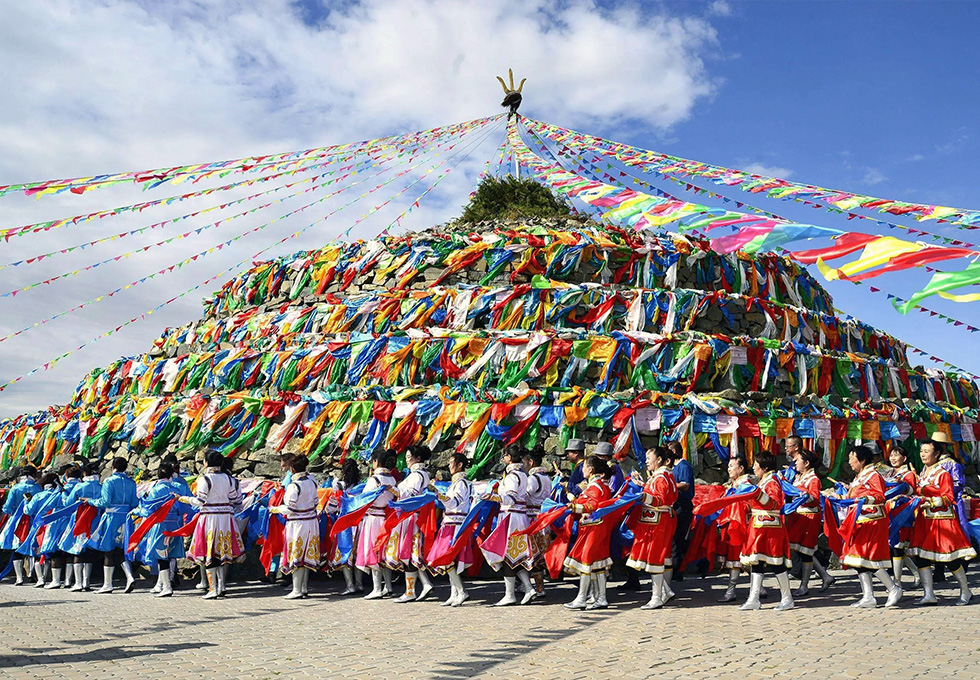 Aobaos Sacrifice: 13th of May in the Chinese lunar calendar
Aobaos Sacrifice: 13th of May in the Chinese lunar calendarThe sacrificial activities in Inner Mongolia are various: offering sacrifices to the sky, god of fire, ancestors, Aobao, etc. Among them, offering sacrifices to Aobaos are the most important one and it demonstrates the people of various nationalities living on the grasslands together. In ancient times, the ancestors of the Mongolian people revered the heaven and earth as the sources for human living and multiplying, so they worshiped them devoutly. Since people didn’t know what gods of heaven and earth looked like, they piled up stones (Aobaos) that served as the symbols of gods. By offering sacrifices to Aobaos, they prayed to gods of heaven and earth for a bumper harvest, thrifty animal husbandry and a peaceful life. There is another legend that explains the origin of Aobao. According to this saying, the prairie is so vast and boundless that people could easily lose their ways in the past; thus, they piled up stones as road signs. This was how Aobaos came into being. Later, Aobaos were gradually regarded as places where gods lived in and the people started offering sacrifices to them. In the past, each region, county, village and temple had its own public Aobao and the rich also had their own Aobaos with many names. Aobao, in the Mongolian people’s eyes, is a sacred place. In the old days, when embarking on a long journey, people would dismount their horses and pray to Aobaos for a safe trip once they saw one. They would later add several stones or a handful of earth to the Aobao and then mounted up their horses to continue the journey. It was in the Qing Dynasty that the custom of offering sacrifices to Aobaos annually with each tribe as a unit.
Sacrificial Activities
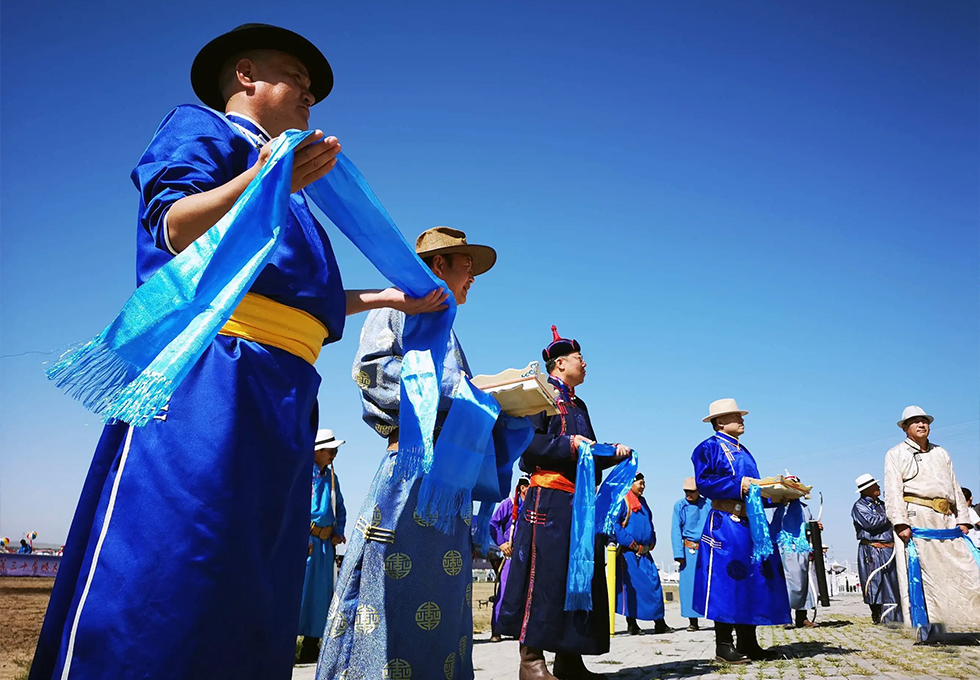 Offering of the Hadas
Offering of the HadasAs the customs and traditions of the herds vary greatly in different regions, not all the time and forms of offering sacrifices to Aobaos are the same. Generally, the time for offering sacrifices is in late May and the beginning of June in Chinese lunar calendar, and sometimes in July and August (in Chinese lunar calendar). During this time, the water is abundant, the grasses are lush and the herds are robust. A single region can offer sacrifices by itself; some regions can jointly do this. The Siklingelei County is the place where the tradition of offering sacrifices to Aobaos is well-preserved.
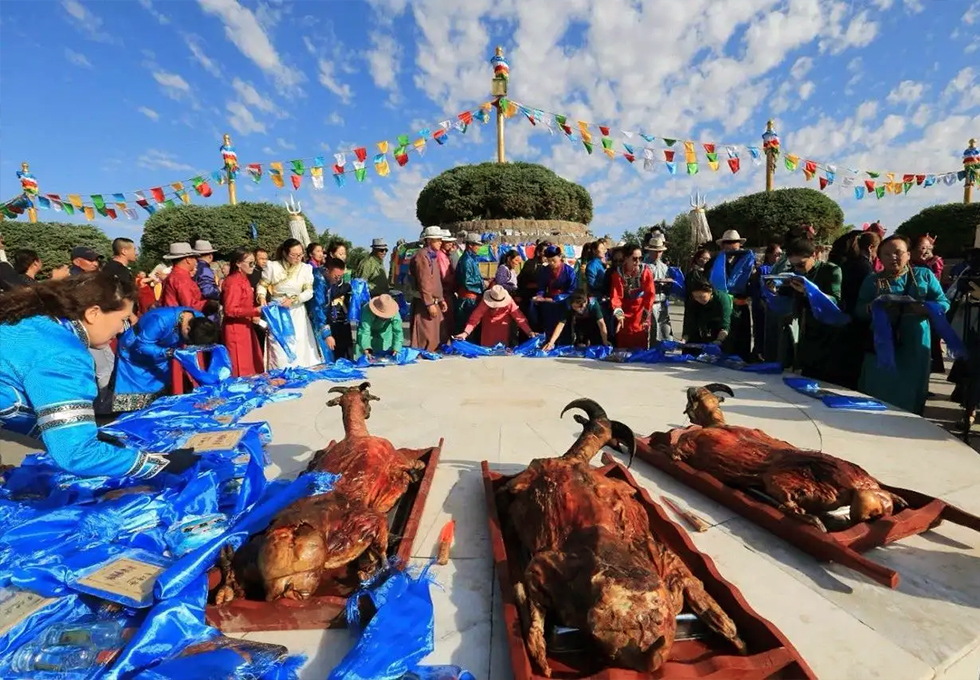 Offering of Lamb
Offering of LambThe scene of offering sacrifices to Aobaos is grandeur. Herdsmen living near the Aobaos would drive their jiggers, ride horses or get on buses to reach the Aobaos with sacrifices such as Hadas, muttons and milk. When offering sacrifices, they offer Hadas and sacrifices first. In some regions, they even ask lamas to recite the scriptures on the spot. Then, they kneel down and perform the kowtow. Afterwards, they add stones to the Aobao or mend the Aobao with willow branches, and hang up new banners of scripture and colorful ribbons. Finally, people that participate in the sacrificial ceremony would walk around the Aobao three times in a clockwise direction and pray for a better life. At the same time, they would offer the milk, wines, creams, snacks and sugars they bring to the Aobao.
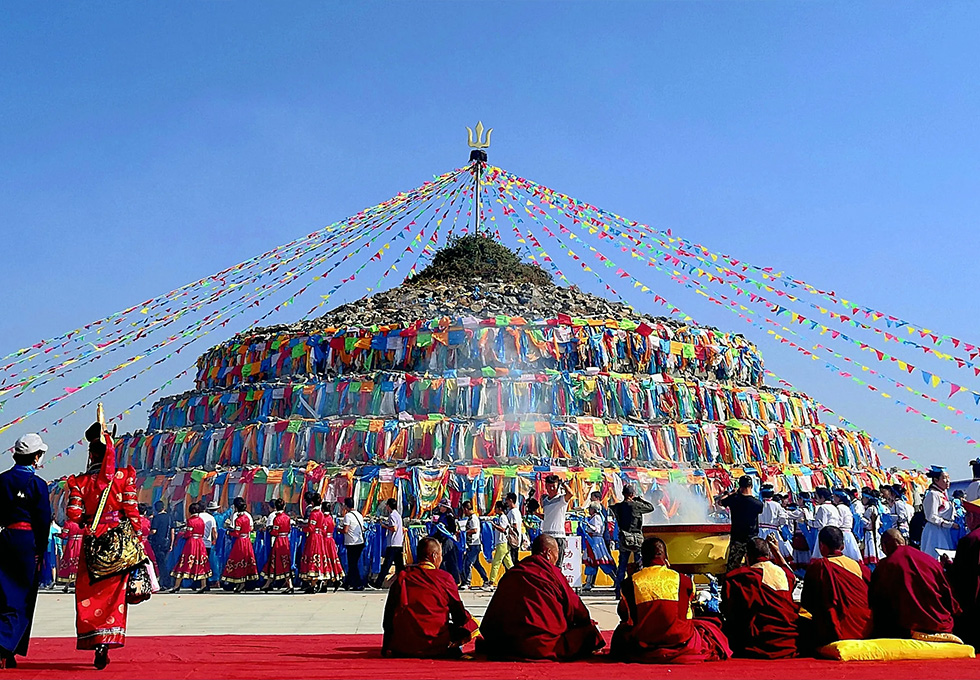 Lama reciting scriptures
Lama reciting scriptures After the sacrificial ceremony, the local people hold traditional activities such as horse-racing, shooting, discus-throwing, singing and dancing. Some of the young men and women would sneak out of the crowd and climb hills together. They open their hearts to each other and fall in love with each other. When it’s time to say goodbye, they ask for the next date. This is what dating after offering sacrifices to Aobaos is defined as.
The Three Feats of the Mongolian Men
The competition of the three feats of the Mongolian men is annually held during the Nadam Fair, where they vary from wrestling, horse-racing and shooting
Wrestling
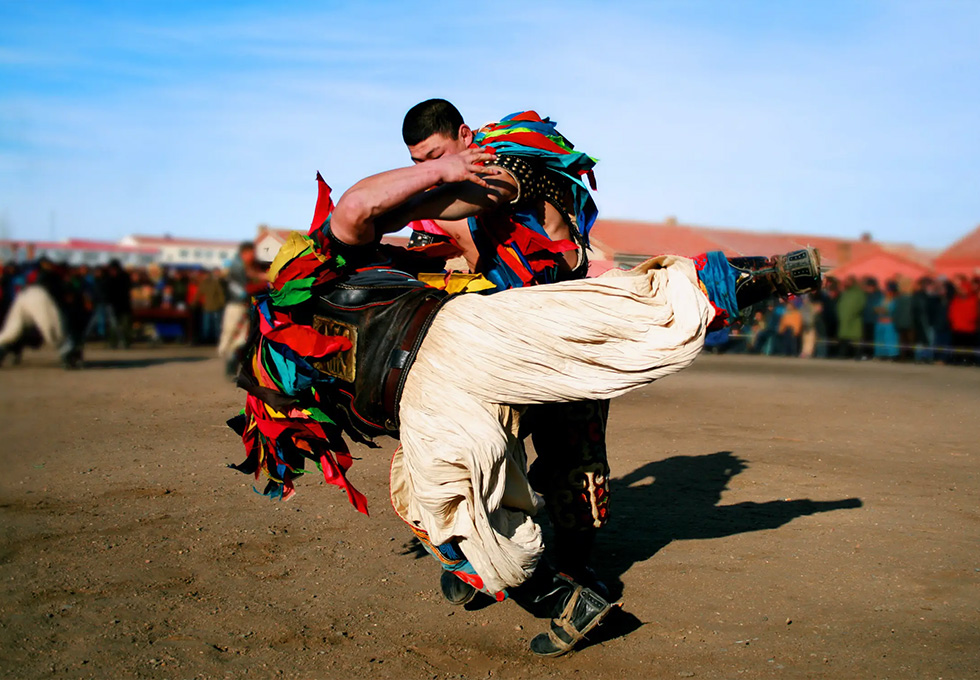 Wrestling
WrestlingWrestling is the most important one in the three feats. After Genghis Khan was elected the khan of Mongolia, he made wrestling an important subject of examination for officials and soldiers. In the folk, wrestling was also designated as the first event of competition during festivities. People adopt one-off elimination system in wrestling. Wrestlers wear high boots, large silk-made wrestling trousers and feather gilets, which are all featured by a unique ethnic style. In the songs of praise, they stride around the round once just like the ancient knights. The wrestler that wins the competition will be awarded with a sheep, several bricks of tea or even a horse with a golden saddle.
Horise Racing
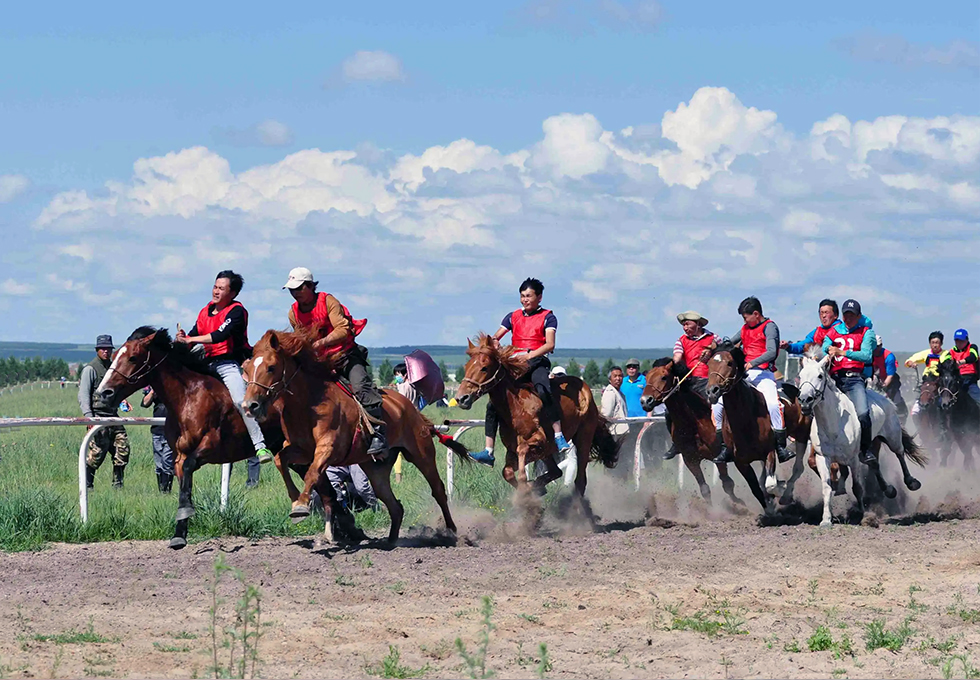 Horse Racing
Horse RacingHorse-racing is one of the most important festivities and the most compelling event. Children are allowed to be involved in horse-racing. The racers stand in a line with colorful belts tied to their waists and bright kerchiefs bond to their heads. By participating in the racing competition, they show their excellent horses and outstanding racing skills. There are two types of horse-racing, including: the normal horse-racing and galloping horse-racing. In normal horse-racing, up to hundreds of people are involved. The racer who crosses the finishing-line first is the most popular and widely acknowledged athlete. He will be awarded with prizes. As to the galloping horse-racing that entails superb racing skills, only adults are allowed. This racing style calls for steadiness, good movements and high speed of the horses.
Shooting
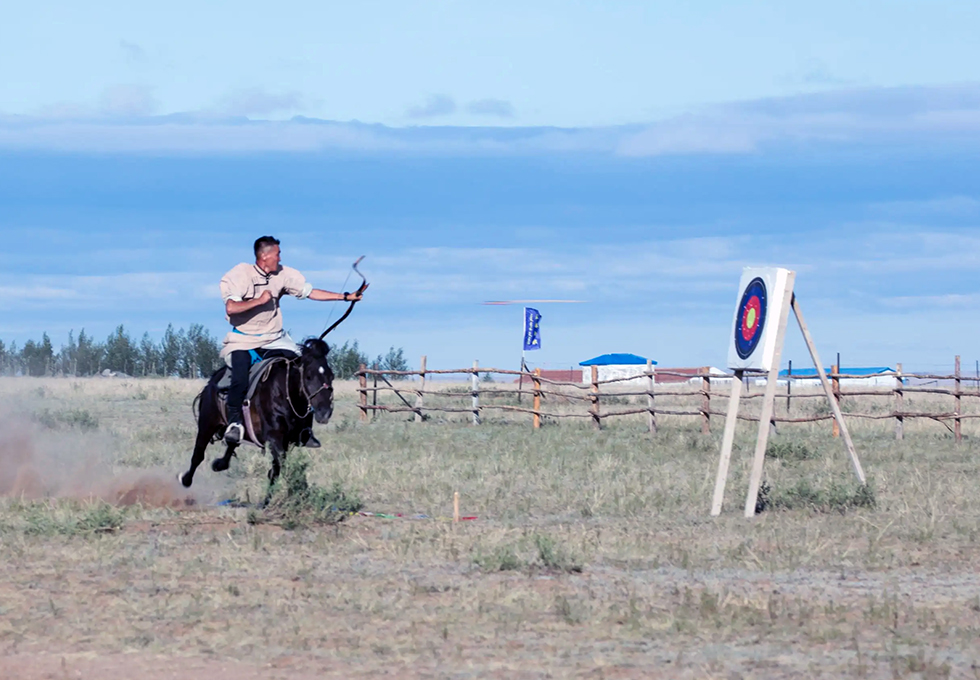 Shooting
ShootingShooting is a recreational competition sport that combines military function and hunting together. There are two types of shooting: standing shooting and horse-racing shooting. When standing shooting, the shape, weight, length and stress of the bows and arrows are various and the distance from the shooting line to the bull’s eye is also different. As to horse-racing shooting, the competitor should shoot while racing with the horse. Excellent shooters are able to shoot with unfailing accuracy, winning over rounds of applauses from the spectators.
Mongol Stringed Instrument
Mongol stringed instrument is the most representative folk musical instrument. Since its end has the shape of a horse head, it has been callethe d “horse head instrument” in Chinese. The structure of Mongol stringed instruments is simple, including a thin and long body as well as a fiddle bow. It can be played solo, duet and concerto. Its sound is deep, booming and sonorous.
 Stringed Instrument
Stringed InstrumentThe Story Behind the Mongol Stringed Instrument
According to the legend, once upon a time, there was a cowboy named Suhe who took care of a lost white horse in the grassland. In the Nadam Fair then, Suhe won the horse-racing with his little white horse. However, he never thought that the rude and unreasonable chieftain would forcefully remove him off his horse. The little white horse shook off the chieftain in an attempt to find his little master—Suhe. The ruthless chieftain sent somebody to shoot the little horse die. Suhe was so grieved that he made a musical instrument with the bones of the white horse and carved a head that resembles that of the little white horse on the top of the instrument. He spent the rest of his life with the musical instrument ever after.
Mongolian Yurts
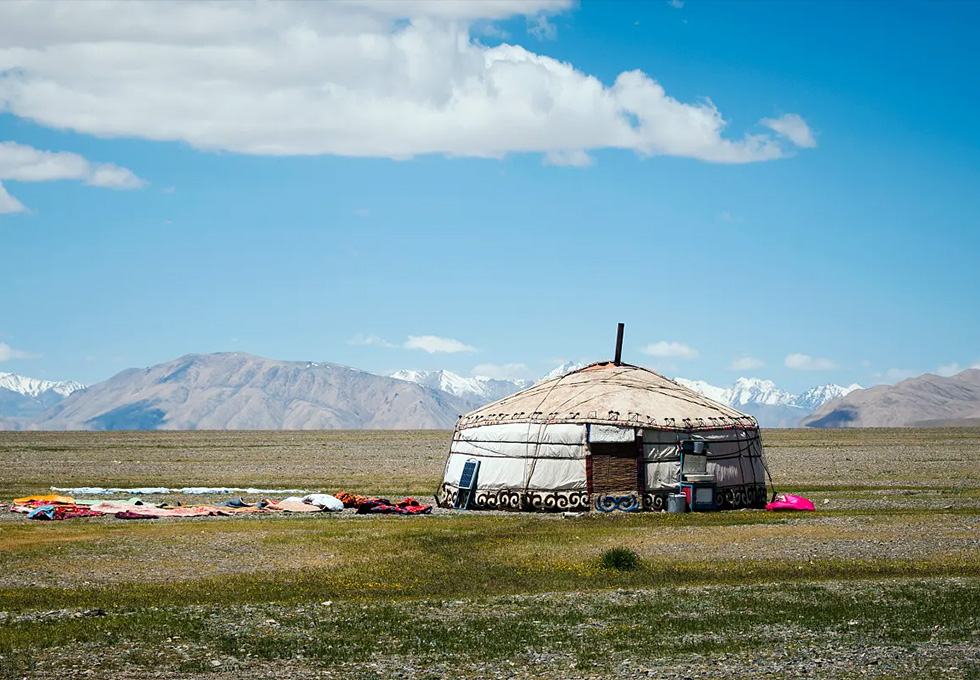 Mongolian Yurt
Mongolian YurtYurts are the places where generations of Mongolians live; they are traveling tents. As the Mongolians lead a nomadic life and live in places where there is water and grasses, they invented a convenient yurt that could be taken up or down.
Yurt has a history of more than a thousand years. It was called “Gonglu” or “Zhanzhang” in the past. It is a cylinder with a spike roof. The yurts are generally supported by struts made from willow and camel-hair strings, with 1 to 2 coats of white felts covering the tops and sides. There is a skylight in the middle of the yurt for daylighting and ventilation.

Useful information on Inner Mongolia
GREAT FAMILY CHINA TOUR
JULY 2024 We wanted to thank Grace at China Culture tour for organizing a great tour of China. We enjoyed our Beijing - Xian-Chengdu -Guilin -Yangshuo - Shanghai trip. Our local guides Bruce in Beijing, Susan in Xian, Jane in Chengdu, Mike in Guilin and Mary in Shanghai took care of us…read more details »
Teng Han L from SINGAPORE
Ready to Create a Unique Dream Travel?
